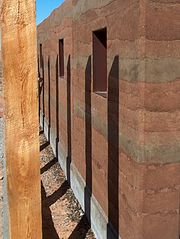| This article needs additional citations for verification. Please help improve this article by adding reliable references. Unsourced material may be challenged and removed. (December 2009) |

Passive solar design using an unvented trombe wall and summer shading
A Trombe wall is a sun-facing wall patented in 1881 by its inventor, Edward Morse, and popularized in 1964 by French engineer Félix Trombe and architect Jacques Michel. It is a massive wall separated from the outdoors by glazing and an air space, which absorbs solar energy and releases it selectively towards the interior at night.
Even single pane glass worked for this process because glass is transparent to visible light but less so to infra-red radiation (heat). Modern variations include insulating glass to retain more of the stored solar heat and high and low, sometimes operable, vents to allow convective heat transfer to the indoors.
Current basic design[]
A Trombe wall

Rammed earth trombe wall built by the University of Utah's Design Build Bluff project
Modern Trombe walls have vents added to the top and bottom of the air gap between the glazing and the thermal mass. Heated air flows via convection into the building interior. The vents have one-way flaps which prevent convection at night, thereby making heat flow strongly directional. This kind of design is an indirect passive thermal collector. By moving the heat away from the collection surface, it greatly reduces thermal losses at night and improves net heat gain. Generally, the vents to the interior are closed in summer months when heat gain is not wanted.[citation needed]
Because temperature variations tend to propagate through dense masonry materials (thermal diffusion) at a rate of approximately 1 inch per hour, daytime heat gain will be available at the interior surface of the thermal mass in the early evening when it's needed. This time lag property of thermal mass, combined with its thermal decrement (dampening of temperature variations), allows the use of fluctuating daytime solar energy as a more uniform night-time heat source.
Common variations[]
Common modifications to the Trombe wall include:[citation needed]
- Exhaust vent near the top that is opened to vent to the outside during the summer. Such venting makes the Trombe wall act as a solar chimney pumping fresh air through the house during the day, even if there is no breeze.
- Windows in the trombe wall. This lowers the efficiency but may be done for natural lighting or aesthetic reasons. If the outer glazing has high ultraviolet transmittance, and the window in the trombe wall is normal glass, this allows efficient use of the ultraviolet light for heating. At the same time, it protects people and furnishings from ultraviolet radiation more than do windows with high ultraviolet transmittance.
- Electric blowers controlled by thermostats, to improve air and heat flow.
- Fixed or movable shades, which can reduce night-time heat losses.
- Trellises to shade the solar collector during summer months.
- Insulating covering used at night on the glazing surface.
- Tubes or water tanks as part of a solar hot water system.
- Fish tanks as thermal mass.
- Using a selective surface to increase the absorption of solar radiation by the thermal mass.
Application in developing regions[]
In Ladakh, India, the Ladakh Project is designing Trombe walls that complement Ladakh's beautiful traditional architecture and has promoted building them in Ladakhi homes. This has shown Ladhakis a clean, reliable alternative to fire as a source of heat. The traditional fuel, dung, burns poorly and offers poor relief from the bitter winter temperatures. The smoldering dung produces significant amounts of smoke that fouls the air and causes many health problems. Trombe walls offer relief from both the cold and the smoke. Ladakh receives about 320 days of sun annually, and the traditional building materials - stone and mud brick - provide the thermal mass needed for heat collection in a Trombe wall.[1]
The Druk White Lotus School in Ladakh uses Trombe walls[2] and as part of "a model of appropriate design and development".[3]
See also[]
- Barra system
- List of pioneering solar buildings
- Solar power in India
References[]
- ↑ Hales, Carolyn (1986). The Ladakh Project. Cultural Survival, 10.3 (Fall 1986) Mountain Peoples. Retrieved from http://www.culturalsurvival.org/publications/cultural-survival-quarterly/hales/ladakh-project.
- ↑ Drukpa Trust (2008). Sustainable Design Examples page. Retrieved from http://www.dwls.org/Sustainable-Design-Examples.html.
- ↑ Drukpa Trust (2008). Overview of Awards page. Retrieved from http://www.dwls.org/Overview-Of-Awards.html.
External links[]
- Community Office for Resource Efficiency A Primer in Trombe Walls with Photos
- Druk White Lotus School website including Trombe wall example.
- Trombe Walls -- NREL page extolling Trombe walls, with no reference to heat loss issues.
ar:جدار ترومب de:Trombe-Wand es:Muro Trombe fr:Mur Trombe pl:Ściana Trombe'a sk:Trombeho stena fi:Trombe-seinä